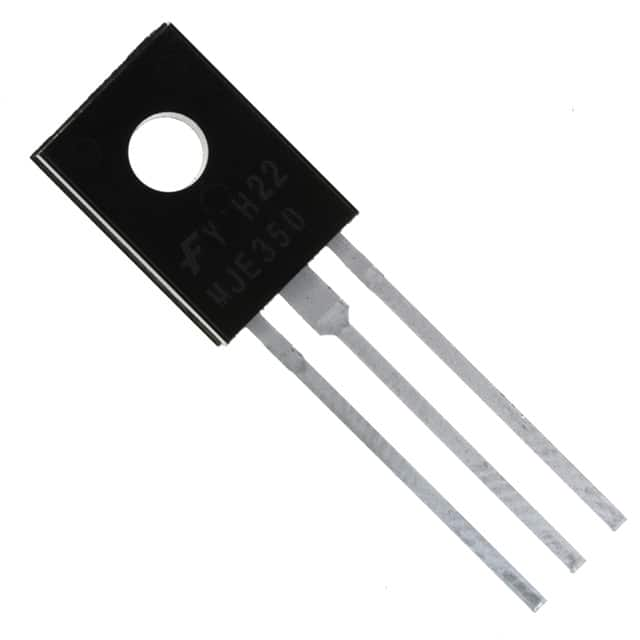Consulte las especificaciones para obtener detalles del producto.

BD681S Transistor: Encyclopedia Entry
Introduction
The BD681S transistor is a crucial component in electronic circuits, belonging to the category of power transistors. This entry provides an overview of the BD681S, including its basic information, specifications, pin configuration, functional features, advantages and disadvantages, working principles, application field plans, and alternative models.
Basic Information Overview
- Category: Power Transistor
- Use: Amplification and switching applications in electronic circuits
- Characteristics: High current and voltage capability, low saturation voltage
- Package: TO-126
- Essence: Silicon NPN Darlington transistor
- Packaging/Quantity: Typically available in reels or tubes containing multiple units
Specifications
- Collector-Base Voltage (VCBO): 100V
- Collector-Emitter Voltage (VCEO): 100V
- Emitter-Base Voltage (VEBO): 5V
- Collector Current (IC): 4A
- Power Dissipation (PD): 36W
- Transition Frequency (fT): 2MHz
- Operating Temperature Range: -65°C to 150°C
Detailed Pin Configuration
The BD681S transistor has a standard TO-126 package with three pins: 1. Collector (C) 2. Base (B) 3. Emitter (E)
Functional Features
- High current gain
- Low saturation voltage
- Built-in protection diode for inductive loads
Advantages and Disadvantages
Advantages
- High current and voltage capability
- Low saturation voltage reduces power dissipation
- Suitable for high-power applications
Disadvantages
- Relatively large package size compared to SMD alternatives
- Limited frequency response for high-speed applications
Working Principles
The BD681S operates based on the principles of amplification and control of current flow. When a small current flows into the base terminal, it controls a much larger current between the collector and emitter terminals, enabling signal amplification and switching functions in electronic circuits.
Detailed Application Field Plans
The BD681S transistor finds extensive use in various applications, including: - Audio amplifiers - Power supply circuits - Motor control systems - Lighting control circuits - Switching regulators
Detailed and Complete Alternative Models
Several alternative models to the BD681S include: - TIP122 - 2N3055 - MJ15003 - MJE13005
In conclusion, the BD681S transistor serves as a vital component in electronic circuits, offering high current and voltage capabilities, low saturation voltage, and versatile application possibilities across different industries.
Word Count: 366
Enumere 10 preguntas y respuestas comunes relacionadas con la aplicación de BD681S en soluciones técnicas
What is the BD681S transistor used for?
- The BD681S is a PNP power transistor commonly used in audio amplifiers, voltage regulators, and power supply circuits.
What are the key specifications of the BD681S transistor?
- The BD681S has a maximum collector current of 4A, a collector-emitter voltage of 100V, and a power dissipation of 36W.
Can the BD681S be used in high-power applications?
- Yes, the BD681S is suitable for use in medium to high-power applications due to its high collector current and power dissipation capabilities.
What are the typical operating conditions for the BD681S?
- The BD681S operates within a temperature range of -65°C to 150°C and is typically used in common emitter configurations.
Is the BD681S suitable for switching applications?
- While the BD681S can be used in some switching applications, it is primarily designed for linear amplifier and regulator circuits.
What are the recommended biasing and drive requirements for the BD681S?
- The BD681S requires appropriate base current and voltage to ensure proper saturation and operation in the active region.
Are there any common failure modes associated with the BD681S?
- Common failure modes include thermal runaway due to inadequate heat sinking and overloading the device beyond its specified ratings.
Can the BD681S be used in automotive or industrial applications?
- Yes, the BD681S is suitable for use in automotive and industrial applications where medium-power amplification or regulation is required.
What are the typical complementary transistors to use with the BD681S?
- Complementary NPN transistors such as the BD680S or similar devices can be used in conjunction with the BD681S in push-pull amplifier configurations.
Where can I find detailed application notes and reference designs for the BD681S?
- Detailed application notes and reference designs for the BD681S can be found in the manufacturer's datasheet, application notes, and technical literature.

